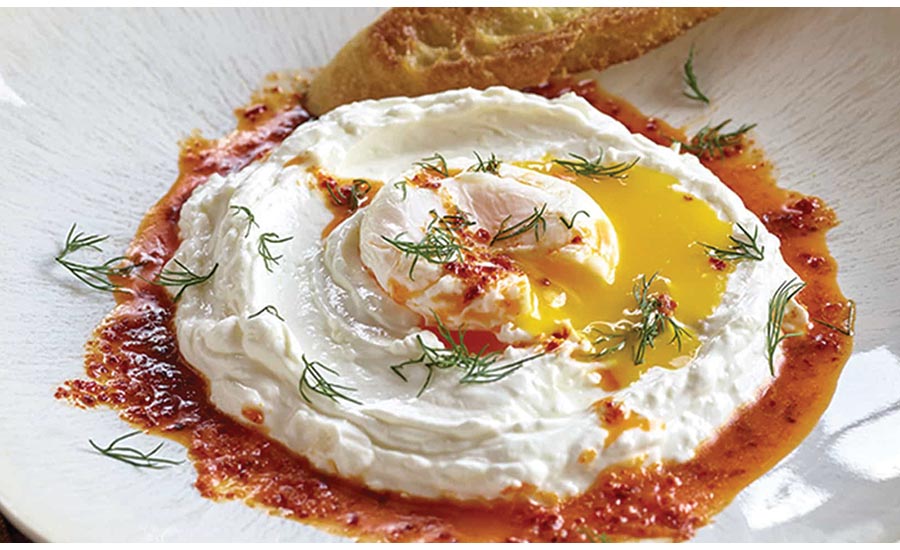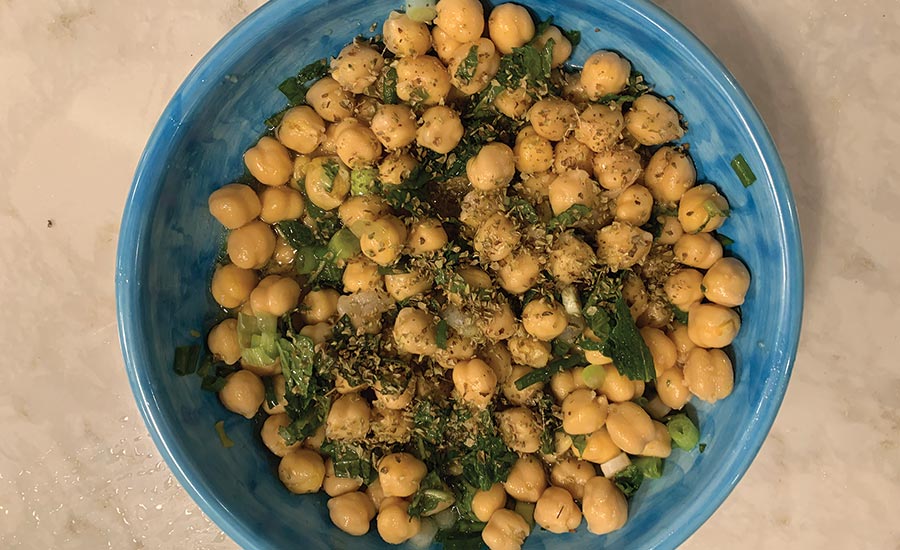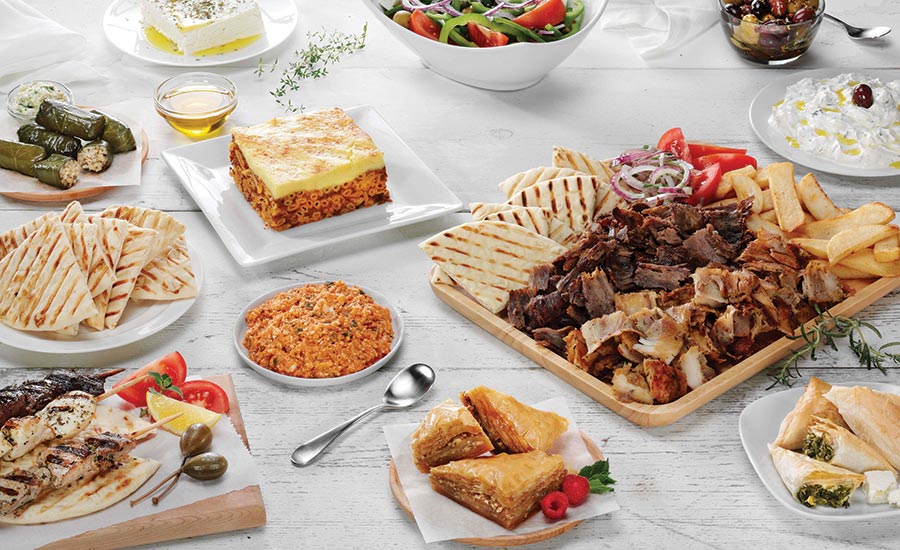Mediterranean cuisine often brings to mind classical examples like Italian food, and easily adaptable ingredients such as olive oil and pasta. But today’s Mediterranean is represented by less familiar dishes and ingredients from all over the region. There are some basic similarities, but also vast differences between, for example, the foods of Malta, cuisines of the eastern Adriatic countries, and those of Israel, Syria, and Lebanon.
Cyprus and Turkey are rich with Near Eastern food traditions of their own, and Egypt, Tunisia, Libya, Morocco, and Algeria meld Arabic and African influences into unique harmonies. All of these diverse contributors offer research chefs and other product developers ample opportunities to create sides, appetizers, entrees, and desserts that are uncommon yet still distinctly Mediterranean.
Certainly, in the US the concept of Mediterranean food has changed over the past two decades. “When I moved to America, Mediterranean food was considered by Americans as mostly Italian,” recalls Mehdi Zarhoul, head chef and owner of Crazy Pita Rotisserie. “They saw it as pasta, lasagna, and fettuccini,” he says. “Today, it is more about the entire region.”
According to a recent Mintel report, “more varied Mediterranean ingredients and flavors are expanding consumers’ palates and along with them the possibilities for Middle Eastern food.” Americans are widely familiar with staple Middle Eastern foods like hummus and falafel, but they are fast becoming acquainted with such favorites as zhug, the Yemenite-Israeli hot chili paste condiment.

The explosive popularity of shakshuka, a spicy egg and tomato dish popular from Algeria to Israel to Libya and beyond, exemplifies how welcoming consumers are to unfamiliar Mediterranean flavors. PHOTO COURTESY OF: American Egg Board (www.incredibleegg.org)
Consumers are becoming increasingly aware of and receptive to regional, specialized flavors from specific Eastern Mediterranean locations like Israel, Yemen, Lebanon, and Syria, according to the Mintel report. But this trend also has opened the door to interest in other, lesser known— and untapped — regions surrounding that great body of water which has served as a cultural crossroads for thousands of years.
In 1993, Oldways Preservation Trust, the not-for-profit organization dedicated to helping people adopt healthier diets, teamed up with the Harvard School of Public Health to launch a program to increase Americans’ awareness of the Mediterranean Diet, developed by the group in 1982. “Plant-based eating is a big trend, and the Mediterranean Diet is one of the original plant-based cuisines,” says Sara Baer-Sinnott, co-founder and president of Oldways.
“When you look at the Mediterranean Diet Pyramid, the vast majority of the foods are foods from plants: vegetables, fruits, whole grains, nuts, legumes, seeds, beans, olive oil, herbs and spices. Basil and oregano have been friends to cooks for a while, but now we see other, perhaps stronger and more fragrant herbs and spices like za’atar, turmeric, and cumin,” she adds. “It’s interesting to think about herbs and spices.”
When Oldways updated the Mediterranean Diet Pyramid in 2008, nutrition scientists added herbs and spices for two reasons: First, these ingredients are also known for their health benefits, and second, they give explicit regional identity to dishes. “Examples that can be seen in such simple dishes as tomato and bread combinations from different countries with different spices—bruschetta in Italy, featuring garlic and fresh basil; dakos in Greece, with dried oregano and feta cheese; and pan tomaquet in Catalonia, Spain, typically featuring nothing more than a rub of garlic, olive oil, and a thin spread of crushed tomato,” explains Baer-Sinnott.
Not Italian
“Due to immigration, social media, and travel, there’s been a wide embrace of lesser-known Mediterranean foods,” says Shea Rosen, food scientist and head of culinary development for Mezzetta Family Co. Some of the intriguing dishes Rosen points to include ajoblanco, a chilled white soup from Spain made from Marcona almonds, apples, sherry, garlic, and olive oil. Rosen adds that it predates gazpacho and is often served during the summer months in Spain.
Also noted is Tunisian tajine maadnous. Typically associated with Moroccan tajine meat and vegetable stews, in Tunisia tajine has a completely different meaning, likely influenced by five decades of French colonialism. Tunisian tajine is an egg cake similar to a crustless quiche. It often includes some ground meat (typically lamb), tomato paste, potatoes, and turmeric.
Albania, Bosnia-Herzegovina, Montenegro, Croatia, and Slovenia are examples of underrepresented Mediterranean countries that are capturing attention of foodies seeking flavors that are at once traditional and exotic. “The cuisine of Albania is definitely Mediterranean,” Baer-Sinnott points out. “It is on the Adriatic coast across from Italy and north of Greece. It shares the culinary traditions of Greece and other Mediterranean countries, with a strong focus on plant foods and seafood.”
Albania differs, however, by abounding in heavier meat stews that contain beef as often as lamb. Certain Turkish influences are evident, too, and there are even pasta dishes. “Croatia has more varied regional cuisines,” adds Baer-Sinnott. “The coastal areas are more Mediterranean, while other regions of the country have more in common with Central European cuisines. Interestingly, Croatia was one of the countries that successfully applied to UNESCO for designation of the Mediterranean Diet as an Intangible Cultural Heritage.”
Albanian qifqi is a rice ball dish similar to Italian arancini. Qifqi originates from the southern Albanian city of Gjirokaster. Shaped like meatballs, this dish consists of rice, eggs, and pepper, with the key addition of dried mint giving it a distinct — and decidedly Middle Eastern — flavor. Unlike the typically hand-rolled arancini, qifqi is shaped in a special mold. The necessary equipment could make it more costly for manufacturers to produce, but could also help guarantee a more authentic — and consistent — product.
With its large Muslim population, Bosnia-Herzegovina has stronger Levantine influences evident in its culinary traditions. And Slovenia bridges the Mediterranean with Central Europe, something that shows up in that country’s foods.
“Slovenia’s small coastline is near the northern Italian city of Trieste and its cuisine features more cereal and meat,” explains Baer-Sinnott. “But it also has dishes that are more Austrian heritage — sausage, schnitzel, strudel — so one could say Albania and part of Croatia have a Mediterranean cuisine, while the cuisines of part of Croatia and Slovenia are more Central European.”
Even desserts are being influenced by Mediterranean cuisine. According to a recent Mintel blog, “Consumers all over the world are increasingly whisking in some tahini.” Whether it’s being blended with chocolate or added to cookie dough, tahini — sesame seed paste — is becoming a popular ingredient in pastry kitchens outside the region.
Basics
Because the Mediterranean is so agriculturally rich, certain fundamentals can be found in most cuisines from throughout the region. Olive oil, garlic, and tomatoes are a culinary “Holy Trinity” to the Mediterranean, just as onion, celery, and bell pepper are to Cajun cuisine. Herbs and wild greens figure largely, as do all kinds of seafood, and poultry is ubiquitous.
From there, certain parts of the region share more distinct regional basics. For example, Israel and the Eastern and North African Muslim countries do not include pork dishes, and shellfish is absent from Israeli food traditions as well. Yet these countries place more emphasis on pungent spices and chili peppers than northern and Western Mediterranean nations do. And while all have their grains and farinaceous staples — especially Italy with its unmatched catalogue of durum wheat pasta dishes and noodle shapes — starches and the grains they’re made from differ across the region.

The health of the Mediterranean Diet has helped drive interest beyond the well-trodden Italy, Greece, France, and the Levant to Malta, the Balkans and beyond. PHOTO COURTESY OF: Oldways Preservation Trust (www.oldwayspt.org)
Baer-Sinnott cites an example of a classic dish that references many parts of the Mediterranean yet is entirely unique: kisir from Gaziantep, Turkey. The cracked wheat dish is similar to Lebanese tabbouleh, but instead of parsley, lemon, garlic, onion, and fresh tomato, kisir mixes the bulgur with tomato paste, pomegranate molasses, medium-hot maras pepper, and spices.
From Cyprus, a dish called koupes demonstrates another take on cracked wheat. “Koupes is a street food often served as a snack, party finger food, or appetizer,” says Greek food blogger Ivy Liacopoulou. “Its crust is made of bulgur wheat, flour, oil, salt, spices, and onion. This is then stuffed with ground meat, lots of onions, parsley, and more spices. Traditionally, koupes was sold on Sunday mornings outside of the church. Today they are sold in supermarkets and bakeries throughout Cyprus and Greece.”
The Spread of Chickpea
One popular Mediterranean dish that only recently became an American staple is hummus. The basic paste of puréed chickpeas and tahini is known from Greece to Saudi Arabia, but its popularity is especially concentrated in Israel and Lebanon. Yet there is no one hummus.
Textures and ingredients vary by country and even by regions or families. There is chunky hummus, smooth hummus, fluffy hummus. Other differences abound with this classic. “Some serve it warm or room temperature, others cold,” notes Paul Nirens, founder of GalilEat in Galilee, Israel. “And some serve it with spice paste or chili pepper.” In Greece, hummus often includes Greek yogurt and cumin.
In America, where hummus has grown enormously in popularity, sweet versions of the dip are now popping up. “Some people are appalled by the idea of sweet hummus,” says Mary Dawn Wright, executive chef at Sabra Dipping Company, LLC. “But they have a more strict idea of what hummus is. In the US, everyone loves a little something sweet and all of us are looking for options we can feel good about eating. With the current overriding trend of plant-based eating, the varied cuisines of the Mediterranean provide ample opportunity for both — and hummus lies squarely in the ‘sweet spot’.”
Wright credits hummus’ huge popularity boom to its great flavor, versatility, and being an excellent source of plant protein. “Consumers have caught on to the fact that hummus is not just a dip to be used as a snack but a versatile food that can be eaten at breakfast, lunch, dinner, or even dessert.” Dark chocolate hummus dessert dip has been a quick hit in the US for that reason. “It can be used in everything from breakfast on toast to snacking with pretzels or graham crackers to dessert with fresh fruit,” adds Wright.
“Trends are always a thought-starter for recipe development,” says Thomas Leo, corporate executive chef for Grecian Delight Foods, Inc. Leo has been developing new hummus recipes that introduce consumers to lesser-known Mediterranean ingredients. “Layering bold flavors in compelling, consumer-friendly options takes extensive kitchen exploration,” he adds. “We know that consumers are more prone to try something new if combined with the familiar. That’s why I decided to combine the Yemeni hot sauce zhug with the more familiar hummus. Consumers have a desire for heat and zhug delivers it in an intriguing, global condiment with high consumer appeal. Zhug is currently in the inception stage of the menu adoption cycle, just starting out in specialty grocers and fine dining. By blending it in with a traditional hummus, it is now accessible to a broader base of consumers and can build growing awareness.”
Fusion Future
Mezzetta’s Rosen also describes some of the new products he’s been developing using more exotic herbs and spices. Combining spice blends such as za’atar — a favorite of Syrian, Israeli, and Lebanese cuisines — with olives from Italy, he’s giving a bold new note to marinated olives. Za’atar is typically a mix of dried hyssop, sumac, thyme, and toasted sesame seed. But in ancient times, it also included powdered olive wood.
Additionally, Mezzetta is launching a line of olives marinated with smoked paprika from Spain, creating a “sofrito” flavor. “There are even ways to inject new life into classics like marinara,” Rosen remarks. “In southern Italy they don’t have hot sauces, but what they do have is chunky peppers marinated with garlic and oil. This inspired me to develop a Calabrian chili and garlic pasta sauce based on these Italian staples.”

The key to folding trending cuisines into the mainstream is through combining the familiar with the exotic in just the right balance. PHOTO COURTESY OF: Grecian Delight Foods, Inc. (www.greciandelight.com)
There are other ways to bottle the flavors of the Mediterranean. “I believe the key to finding the right combination is quality and freshness,” says Rosen. “Manufacturers must look at specific tomato and herb varieties, growing conditions, soil conditions, harvesting and agriculture practices. All of these factors will influence flavor.”
Technique, of course, also plays its part. Many Mediterranean recipes, from pasta amatriciana to Maltese soups such as kusksu and aljotta, have been prepared in family kitchens for generations. The challenge is for a manufacturer to emulate those flavors consistently on a large scale. “It is more time-consuming,” cautions Rosen, “but it can be done. One of the simplest ways is to implement processes that match the home-cooked style of preparation. This could mean sautéing individual ingredients versus dumping everything into a kettle and cooking together. While some companies might choose not to do that, it is an excellent way to create authentic and quality Mediterranean flavors.”
A transformative trend that is emerging is “personalized authenticity,” says Stephen Kalil, certified executive chef and certified research founder and owner of the food think-tank Flavor Design Studio. “At Flavor Design, much of our time is spent consulting with start-ups and participating in brainstorming sessions to gain a futuristic approach as to where foodservice is evolving.”
As societies become more multicultural, food evolves to become more personally authentic. “For example,” says Kalil, “a British-raised chef with a Spanish mother and Indian-Lebanese father would be more inclined to create a Mediterranean fusion of Roasted Red Pepper Dip with hazelnuts, yogurt and Madras curry powder as opposed to a classic Romesco or Muhummara.”
The expansion of interest in the whole of the Mediterranean region’s culinary offerings comes as no surprise to Baer-Sinnott. “The Mediterranean Diet has been named the number one overall diet by US News and World Report for the last several years,” she says. “There is so much research supporting the health benefits of the Mediterranean Diet, with hundreds of physicians recommending it to their patients.”
As more and more people develop an interest in returning to their roots, or exploring other cultures through cooking at home, lesser-known dishes are being embraced. Gone are the days of lasagna or fettucine being synonymous with “Mediterranean cuisine.”
This article originally appeared in the October 2020 issue of Prepared Foods as New Mediterranean.




